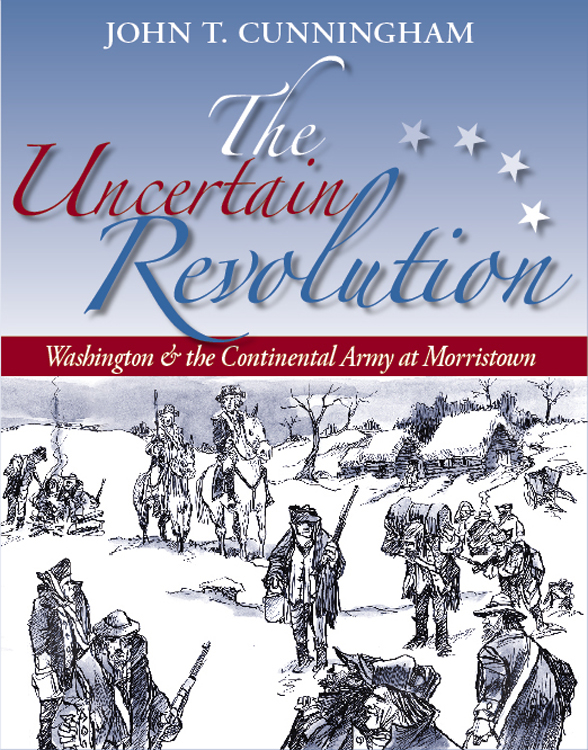The mountain ridges offered the safety and security Washington needed for winter quar–ters, which he established within or close to the formation. He set up winter camps twice in Morristown and a third time on one of the Watchung‚s southern slopes, about fifteen miles due south of Morristown.
Then, for the winter of 1780-81, while he spent the winter in New Windsor, New York, Washington sent 2,500 men, a substantial force ˜ about half his main army ˜ back to Morristown for yet another winter. No other area of the infant United States, from Savannah to Boston, came close to the Watchungs in constant military importance.
Washington's obvious strategy throughout the war was to avoid extended direct open field conflict with the enemy. Even the Battles of Trenton and Princeton, for all their brilliance, were "hit and run" affairs. The cautious tactics shielded the precious troops and earned Washington the unseemly sobriquet of "the master of defeat and retreat."
The commander‚s armies were at least elusive and often evanescent, particularly in winter when many men drifted away from camp The three major winter camps behind the Watchungs were replete with suffering, despair, desertion, thievery, indifference and open mutiny.
Soldiers at Middlebrook faced an indifferent public; farmers sold produce mainly to those offering the highest profits ˆ and if that meant the British, so be it. The American troops were starving, freezing, barefoot, and angry.
The winter of 1779-80 at Morristown tested the army in nearly every conceivable way. The fifth snow of the season was falling on December 1, when the first soldiers reached Morristown and marched south about three miles to begin building log huts for themselves in Jockey Hollow.
Twenty-eight snows fell that winter, and a blizzard in early January 1780 left drifts more than four feet high on the roads. A regimental clothier wrote that some troops were "as naked as Lazarus" and Washington wrote that with respect to supplies, the situation of the army was "beyond description."
Continental money was virtually worthless. Desertions were numerous. Washington had to order farmers to sell food to the army at fair prices or face having grain and beef cattle seized by armed soldiers. Serious mutinies erupted at Jockey Hollow in Morristown in the spring of 1780 and on New Year‚s Day in 1781.
The desperation of woefully abused American soldiers is a basic theme of this book — and nowhere was the suffering or congressional indifference worse than during the horrific winter of 1779-80 at Morristown.
Congress became so annoyed by Washington‚s endless stream of letters describing the evils of that winter that it sent a committee to study the situation, with instructions to cut the numbers of troops and reduce the army budget much as possible. It just couldn‚t believe that things were as bad as the general painted them.
Ten days after it arrived in Morristown, the committee sent one of its members galloping to Philadelphia with a report meant to shatter the complacency of congress. In short, the committee said conditions at Jockey Hollow were far worse than Washington had been reporting.
The construction of present day Route 24 to connect interstate routes 78 and 287, via the original gap, has all but obliterated any evidence of this once-vital passageway. Huge amounts of fill have brought the highway‚s pavement close to the top of the gap. While the road is steep, it hides the old formations that baffled British and Hessian forces throughout the war.
A century and a half, and millions of dollars later, huge machines blasted new gaps through the Watchungs ˜ near Paterson, on Eagle Rock Avenue, along Route 280 at West Orange, and the cuts which speed Route 78 traffic through the column-like formations common to basaltic ridges.
It is hard for the modern visitor to imagine the Watchungs as a defensive barrier. In the late 1700s, behind those towering walls, through swamps and across a broad river, the American army endured for longer periods than anywhere else in America. Despite desperate suffering in the ranks, Washington‚s army survived in their mountain stronghold, and rose again and again to find victory.
E
The two outer Watchung ridges, like the outer walls of a tremendous fortress, rise as high as 879 feet above sea level, just north of what is now Paterson. Elsewhere along the top of the basaltic formation the ridges are between 450 and 600 feet high. Considering that sea level is less than eight miles from the outer ridge, the rise of the formation is precipitous, and in places, cliff-like.
Geological time also saw an ancient ancestor of today‚s Passaic River carve out a deep gap in the ridges, midway on a straight line between Morristown and the lower tip of New York. The location of the gap is uncanny, considering the role it was destined to play in American history.
